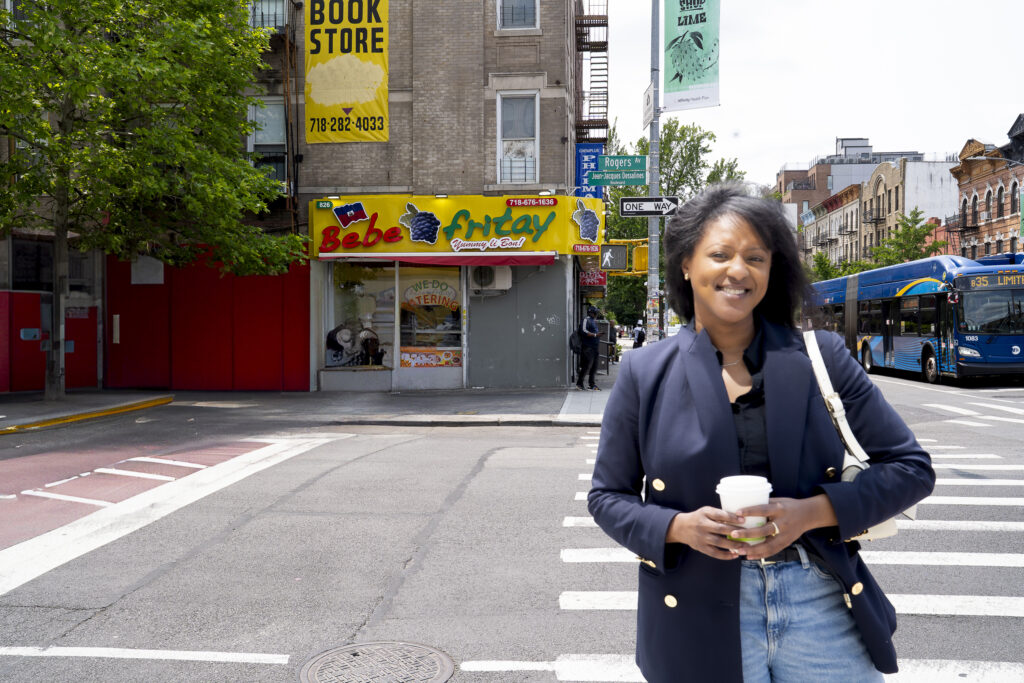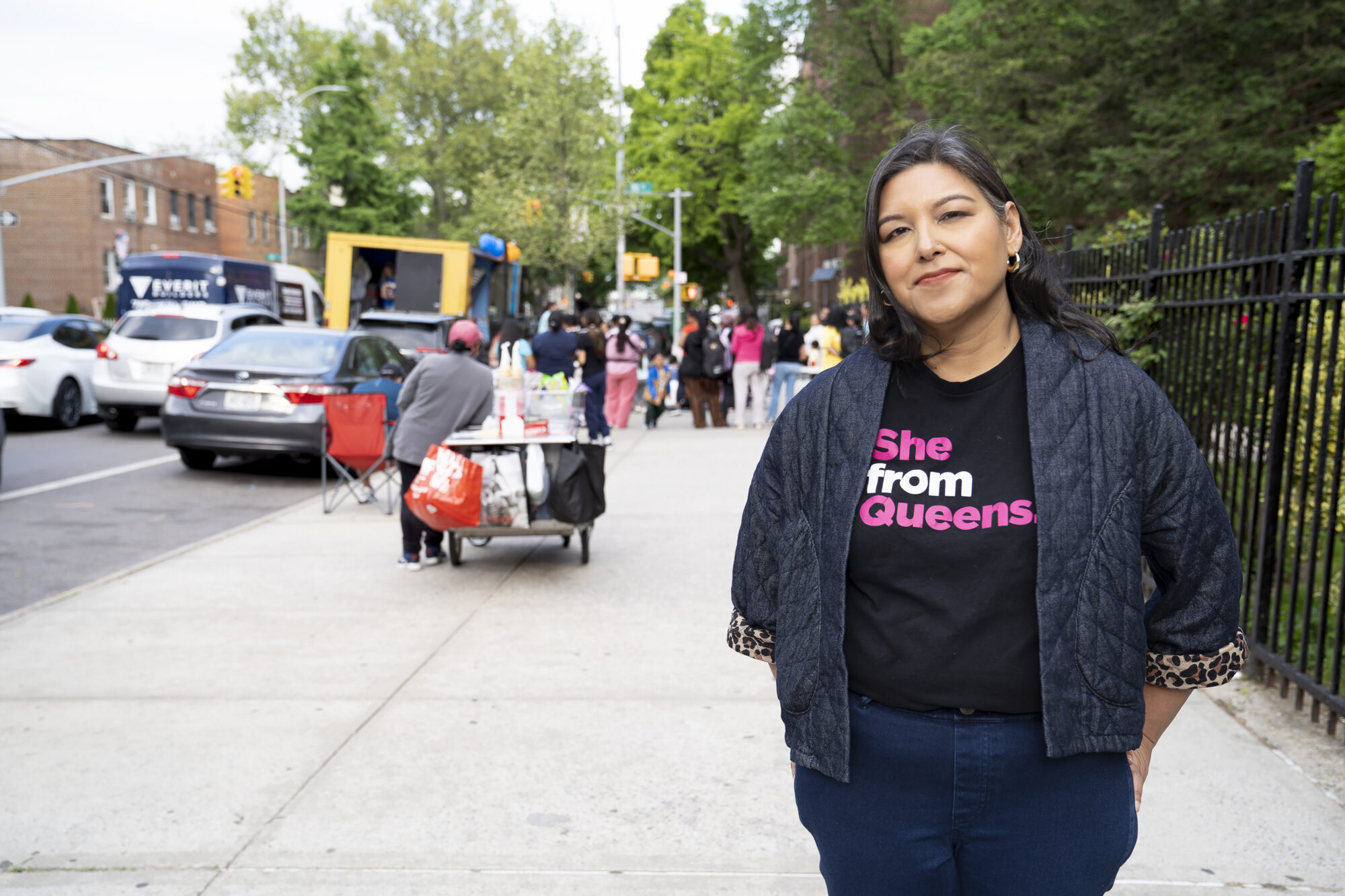It began with a hateful email. The subject line itself was a racial slur: the N-word.
The content was just as insidious, laced with the kind of dehumanizing language often lobbed at the readers we serve. Then came the onslaught: a relentless assault on our social media platforms, websites, and emails. For good measure, individual team members at our news outlet were doxxed and “swatted,” with hoax emergency calls being made to trigger a police response.
For weeks, this toxic wave of hate and racism battered The Haitian Times, the Brooklyn, N.Y.-based publication I had founded. The Times had dared to push back against the racist claims being spread by then-candidates JD Vance and Donald Trump in the final weeks before the 2024 U.S. presidential election. The lies were outrageous — xenophobic propaganda accusing Haitians in Springfield, Ohio, of eating pets.
As the vitriol mounted, the stakes became clear, and they were higher than we had imagined. Local officials, buckling under pressure that included citywide bomb threats, said they could not guarantee our safety if we proceeded with a long-planned convening of the Haitian community in Springfield. We went ahead with the event online. Staff members at The Haitian Times scrambled to monitor and delete nasty, eyebrow-raising comments as soon as they appeared. Legal, security, and advocacy teams tried to help safeguard staffers’ homes.
As the maelstrom intensified, it became clear that this attack wasn’t just about one story, person, or publication. It was an assault on a principle: truth. It reflected a media landscape under siege by political forces at the highest levels, like Trump and Vance, who displayed a brazen goal: to scare people into silence.
That was taking place during the campaign. Now that those candidates are in power, the first few months of President Trump’s second administration have seen his promised “war on the media” play out — with particular vitriol being aimed at immigrants and the media that serve them.
These outlets find themselves having to navigate an increasingly hostile and precarious environment even as their role becomes more vital than ever. Not only are they a primary source for keeping their communities informed about fast-changing immigration decrees that affect them, many increasingly have to work to debunk rumors and mis- and disinformation that are running rampant. In addition, outlets are feeling the added pressure of their advertising base — often immigrant-owned or small community businesses — pulling back on their support out of fear of being targeted.
While mainstream media organizations typically possess the legal teams and financial backing to push back against frivolous lawsuits, fight for access to information, and absorb public funding cuts, independent immigrant publishers rarely have such resources.
In Phoenix, Arizona, the immigrant-led newsroom Conecta Arizona is navigating a new crisis: widespread fear over potential nationwide raids by U.S. Immigration and Customs Enforcement (ICE). Founded in 2020 by Maritza L. Félix to counter misinformation, the team now faces direct threats due to their immigration statuses.
With only two U.S. citizens on staff, the rest are on precarious visas or Deferred Action for Childhood Arrivals (DACA). They take extreme precautions when covering protests, including writing lawyer hotlines on their arms and planning escape routes. As Félix explains, "If something happens, it's not a fine and bail — it could be a one-way ticket out of the country."
Conecta Arizona provides fact-checked news and legal resources to Spanish-speaking immigrants. Despite a wide reach and a $400,000 budget, Félix stresses the urgent need for legal support tailored to immigrant journalists.
“Being here, even with legal status, is still considered a privilege, not a right. And that privilege can be taken away at any moment — just for doing our jobs,” she says.
On top of these challenges are the harsh business realities already threatening small, independent media outlets in the digital era. Some have lost vital advertising revenue in the transition to digital, while changes with social media and AI have made it harder for publishers to find their audience. Others have never fully recovered after pandemic-era disruptions.
As a result, many ethnic media organizations are rethinking their revenue and business strategies, recognizing that the traditional model of community-based advertising may no longer be sustainable in today’s climate.
As the very notion of a free press comes under siege, immigrant-serving media outlets find themselves on the front lines of a battle for survival, yet again.
— Maritza L. Félix, founder and director of Conecta Arizona
“Being here, even with legal status, is still considered a privilege, not a right. And that privilege can be taken away at any moment — just for doing our jobs.”
Deep roots in America
Long a symbol of resilience, the immigrant-serving press in America has stood as a testament to the power of words in the fight against marginalization. The strength of these newspapers, many with roots in the 1800s, lay in their enduring ability to serve as both news outlets and advocates for their communities as they evolved.
During the 19th century, waves of immigrants from countries such as Ireland, Germany, Italy, and China arrived in America bringing not only their labor but their languages, cultures, and identities. For these groups, their newspapers were more than just a way to communicate — they were essential tools for survival, helping newcomers navigate their new surroundings with critical information, often in their native tongue.
Throughout the 1800s, immigrant communities used newspapers and other forms of media to carve out a space for themselves, asserting their rights and resisting the forces of xenophobia, racism, and discrimination. These publications often fought battles on multiple fronts: advocating for labor rights, challenging discriminatory laws, and pushing back against false narratives that painted them as inferior or dangerous. They provided critical information about immigration policies, labor laws, and social services that many immigrants did not have access to otherwise. They also offered a sense of community, a place where immigrants could share their stories, voice their concerns, and find solidarity.
Today, there are more than 700 outlets categorized as ethnic media in the United States, according to a recent study by Northwestern University’s Medill School of Journalism. Organizations like The Haitian Times — which I founded in 1999 — have built upon that legacy. They provide their communities with vital services, from health and legal advice to local government updates and emergency response information. Community media are often the only outlets reporting on issues directly affecting immigrant communities, from local school policies to housing rights. They also help immigrants navigate complex legal systems, providing information about citizenship applications, refugee status, and asylum procedures.
After more than six years at The New York Times, I launched The Haitian Times because I saw that the Haitian community was evolving from an exile group to an established immigrant community and had no credible information about the community and country.
I joined my parents a few years after they had migrated to New York City in the late 1960s. They were among the first wave of Haitian immigrants fleeing Papa Doc Duvalier's self-proclaimed lifelong presidency. At that time, New York's Haitian community was a close-knit group, largely composed of middle-class families from Port-au-Prince and the capital city’s suburbs. My parents and their friends often reminisced about their beloved, yet troubled, homeland.
They all believed they would return one day. Yet, three decades later, they remained, and the community here swelled as the political situation back home deteriorated.
I saw an opportunity to provide this emerging generation of Haitian Americans with a news outlet that reflected their aspirations and challenges. The existing publications weren’t resonating with my generation, so I wanted to follow the long tradition of immigrant press — not just reporting the news, but serving as essential hubs of information.
However, I worried about the longevity of such a project. At the time, many ethnic publications were disappearing across the country, such as the New York-based Il Progresso Italo-Americano. Once the largest Italian language daily in the U.S., its closure in the late 1980s — after more than a century in business — marked the end of an era for the Italian American immigrant press.
I didn’t want The Haitian Times to have a short lifespan. I wanted to build an institution. To gain perspective, I sought the advice of publishers from the Irish Echo and The Forward, formerly The Jewish Daily Forward. Both reassured me that no matter the generation, their readers remained deeply connected to their culture. In fact, many of the Irish Echo’s readers at the time were several generations removed from Ireland, but still felt an enduring link to their heritage and country of origin.
A vital role in serving the community
As I learned, immigrant-serving media outlets are lifelines — at times, literally. During the early days of the COVID-19 pandemic, many outlets were at the forefront of providing life-saving information, especially as misinformation about the virus and vaccines spread rapidly.
When COVID-19 brought the world to a standstill, The Haitian Times mobilized. I convened an ad hoc committee of community leaders to guide Haitian New Yorkers through the unprecedented uncertainty. We launched a WhatsApp group and dedicated phone lines, delivering crucial information and connecting residents with vital financial and health resources.
Our efforts extended further. We organized a virtual music festival, attracting over half a million viewers and raising nearly $50,000 to support our local community and a health clinic in Haiti.
Longtime journalist S. Mitra Kalita also found herself responding to a huge demand for pandemic-related information from neighbors in her immigrant-heavy neighborhood in Queens, New York. It led to her co-founding Epicenter NYC — today a successful model of community-engaged journalism — which seamlessly blends reporting with direct action on behalf of her readers. Epicenter has connected over 10,000 New Yorkers to crucial resources through more than 600 hours of in-person engagement, fostering trust across 60+ partnerships with schools, libraries, civic groups, and faith organizations.
Lately the focus has been helping immigrant readers by participating in “Know your Rights” campaigns and debunking false information that readers bring to their attention.
“The question of ‘is this journalism?’ became secondary to the humanity with which we approach our work,” says Kalita, who also co-founded URL Media, a group of minority-owned local media outlets, with Sara Lomax. “It’s not just about reporting the story but getting what’s being reported into the communities that need to access information.”
Battling misinformation
Online misinformation presents another urgent challenge for immigrant-serving media. With platforms like WhatsApp, Facebook, and TikTok serving as primary news sources, the spread of false information is rampant, often with disastrous consequences. Misinformation can often mean the difference between life and death — especially around issues like immigration policy or health advice.
The Chinese-language newspaper Sing Tao Daily in New York has faced profound challenges posed by misinformation in the community. Rong Xiaoqing, a veteran reporter for the paper, says language barriers and unfamiliarity with U.S. institutions make it harder for many Chinese immigrants to verify information, creating a fertile environment for false narratives to take root. "Immigrants' understanding of the system, culture, and social norms of the U.S. is often incomplete or inaccurate ... Many people believe almost everything they find online," she says.
But the problem goes deeper. Rong points out that the rise of social media influencers — many of whom have no journalistic training — has compounded the issue. “They’re very good at using social media platforms to package themselves, to push out information that sounds believable, but is not based on facts."
The Haitian Times took a proactive approach, including real-time fact-checking, explainer articles, and direct engagement with their audiences. "We are constantly listening to our readers and the conversations happening in the comments," says Vania André, editor in chief and publisher of The Haitian Times. "If we see a rumor or confusion spreading, we respond with an explainer article to clear things up."
But it remains a constant battle, says Daniela Gerson, an associate professor of journalism at California State University, Northridge. "Fear moves very quickly,” says Gerson. “And rumors move very quickly. And the truth is a snail."

The financial squeeze: shrinking revenues, expanding responsibilities
For years, community outlets relied on advertising from local businesses and reader support. But the digital era has left many small publications financially unable to fully transition to digital-first models to reach a broader audience and generate new revenue streams.
"They are either far behind the curve or just beginning," says Jehangir Khattak, a longtime observer and advocate for ethnic media who is communications director at the Center for Community Media at the City University of New York’s Craig Newmark Graduate School of Journalism. "Some of them have gone beyond the curve, like The Haitian Times, but others are still struggling to gain a foothold in the digital world."
Khattak draws a direct correlation between immigration crackdowns and the erosion of local business ecosystems that once sustained immigrant-serving outlets. As federal enforcement ramped up, and anti-immigrant rhetoric surged, fear took hold — causing many businesses to scale back or shut down altogether.
“When immigration policies started affecting businesses, a lot of businesses started to close... They stopped advertising. So that’s a huge, huge impact,” Khattak said. “The local advertisements, those are also really going down... some of them have gone on the other side of the curve... others are still struggling.”
To survive, some outlets have turned to alternative funding models, including events, membership programs, and philanthropic partnerships. However, these revenue streams come with their own challenges. Grants are difficult to secure. Often, they come with strings attached, requiring outlets to narrow their focus or change editorial direction to fit funders' priorities.
André of The Haitian Times says a major challenge for media outlets is the public's misunderstanding of journalism's role and inherent value. People often consume our work through aggregators or platforms, unaware of its origin or the investment required to produce it. Simultaneously, tech giants monopolize audience attention and advertising revenue, forcing independent publishers to contend for both recognition and financial viability.
“We are constantly compelled to justify our worth while competing with platforms that profit from our content without contributing to its creation or long-term sustainability," says André. “So we’re in an environment that’s constantly in flux — one that’s being upended by innovation that could help journalism, but also makes it harder to survive.”
The digital transformation continues
Vandana Kumar co-founded India Currents in 1987 to create a space for the Indian American community, a voice that had long been overlooked. At the time, Indians in the U.S. had few platforms that spoke to their unique experiences, challenges, and aspirations. Vandana saw this gap and knew that a publication could not only serve as a connection for the community but also celebrate their contributions to the fabric of America.
For over three decades, India Currents existed as a print outlet, building a loyal readership that found solace in its pages. But as the world became increasingly digital, Kumar recognized the need to adapt. She pivoted to digital to meet the demands of a younger, tech-savvy audience, who turned to their phones rather than their mailboxes for information. The transition was not without difficulty, but for Vandana, the mission remained unchanged: to provide a voice, to preserve culture, and to connect the community. Digital wasn’t just a shift in format — it was a necessity to continue serving a generation that was evolving in an ever-changing world.

“I had to rebuild the entire organization after 2019,” Kumar said. “We became digital, I could not afford to keep anybody on, so basically let everyone go ... It’s taken us a really long time to make the case to philanthropic organizations.”
In making that case, Kumar faced the uphill battle of proving the value of a publication that at one point had been reduced to a one-woman operation. Although she has slowly rebuilt her team — with four full-time staff and four part-time contributors now supporting the digital effort — the transition made it harder to demonstrate institutional capacity to potential funders. As she notes, the shift to digital was necessary for survival but came at the cost of visibility and perceived stability.
“There are not many funders who understand what we do,” she says. “And even though we have a 35-year track record, they don't quite see how community media fills a different need than mainstream journalism.”
Evolving for long-term sustainability
Advertising is a struggle, and philanthropic funding and grants are hard to come by. So where will immigrant media find its growth in the years to come?
One way is asking the readers themselves. Sarah Gustavus Lim, membership director for the Local Independent Online News (LION) association, which helps independent news publishers build business models like membership programs, says that because many immigrant-focused publications have been “very connected to the community” from the start, LION members like Conecta Arizona and The Haitian Times for example, have been successful in generating financial support from their core audience. The challenge is that memberships don't immediately replace bigger funding sources, and asking people for money can be hard.
— Vandana Kumar, publisher and CEO of India Currents
“There are not many funders who understand what we do. ... They don’t quite see how community media fills a different need than mainstream journalism.”
Across the country, efforts are underway to encourage government support for local media. The Center for Community Media played a key role in passing a New York City law mandating a portion of the budget be allocated to local media. This legislation has been a lifeline for many publications in the city and surrounding metropolitan areas. Similar efforts are underway in states like Illinois, California, and Washington. Many see government support as a crucial revenue slice that can help sustain local journalism. Historically, the government has passed laws aimed at supporting publishers, such as the bulk rate system designed to lower mailing costs and the legal notices that have long been a staple of local print publications. Some media advocates are exploring ways to get governments, local and federal, to extend legal notices to digital outlets.
In early 2024, Zachary Richner, a third-generation publisher whose grandparents founded the Herald Community Newspapers in Long Island, New York, organized a coalition of more than 200 newspapers to advocate for a state tax credit aimed at bolstering local journalism. Their concerted lobbying efforts culminated in the state of New York approving a budget that allocated $30 million annually over three years for these tax credits. This legislation provides refundable tax credits of up to 50% on the first $50,000 of a journalist’s salary, promoting the hiring and retention of journalistic talent across the state.
“It’s a $300,000 refundable tax credit for publishers,” Richner says, emphasizing the importance of ensuring immigrant-serving publications can benefit from such policies. “The hope is that this tax credit will provide some relief, particularly for smaller, underfunded outlets that play a critical role in serving immigrant communities.”
But even with this success, the fight for long-term sustainability continues. As Gerson puts it, “The core question remains: What is the role of immigrant-serving media today? And how do you sustain it in a world that is rapidly shifting away from traditional journalism?”
Standing with our community
I still recall The Haitian Times' humble beginnings: a cramped Brooklyn office, fueled by passion, a few donated computers, and a temperamental fax machine. Initially, I aimed simply to tell untold stories of Haitians like myself, not to become a community leader. However, I soon realized that in immigrant media, reporting on your community isn't enough — you must stand with it.
That truth became undeniable during the Springfield story. What started as local reporting quickly unveiled the profound risks we take, the backlash we endure, and the immense responsibility we carry as immigrant publishers. We were tested, but we held firm — not out of ease, but out of necessity.
This has always been our unspoken role: quiet, urgent, and without fanfare. Journalism, fundamentally, is public service. For those of us serving marginalized communities, sometimes the greatest act of service is simply refusing to look away.
Garry Pierre-Pierre is the founder of The Haitian Times. He was formerly a reporter at The New York Times, where he was part of a team that won a Pulitzer Prize for their coverage of the 1993 bombing of The World Trade Center. He is also the co-founder and founding executive director of the Center for Community Media at the City University of New York’s Craig Newmark Graduate School of Journalism.




